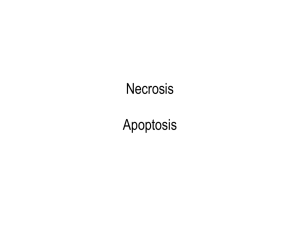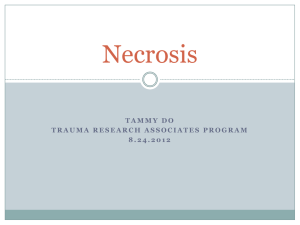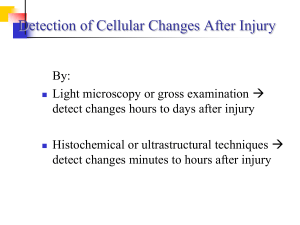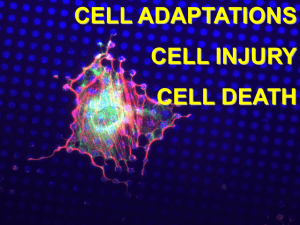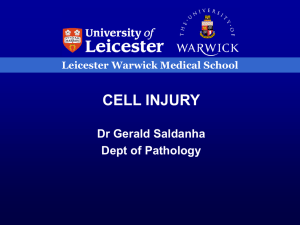Necrosis and apoptosis
advertisement
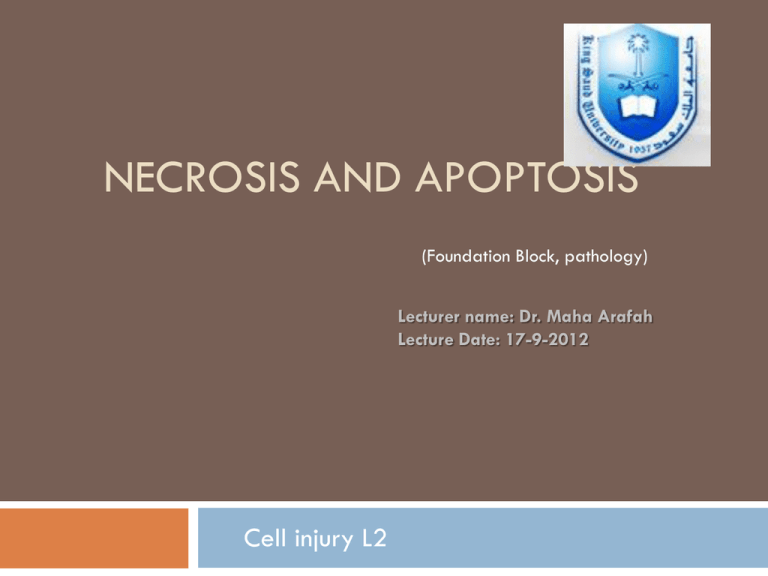
NECROSIS AND APOPTOSIS
(Foundation Block, pathology)
Lecturer name: Dr. Maha Arafah
Lecture Date: 17-9-2012
Cell injury L2
Objectives
List causes of cell injury
List mechanisms of cell injury
Understand the changes in reversible and
irreversible cell injury
Define necrosis and apoptosis
List the different conditions associated with
apoptosis, its morphology and its mechanism
List the different types of necrosis, examples
of each and its features
Know the difference between apoptosis and
necrosis
Etiologic agents
1. DEFICIENCY OF OXYGEN
Ischemia vs. Hypoxia
2. PHYSICAL AGENTS
3. CHEMICAL AGENTS
4. INFECTION
5. IMUNOLOGICAL REACTIONS
6. GENETIC DERANGEMENTS
7. NUTRITIONAL IMBALANCE
8. AGING
Brain – massive haemorrhagic focus (ischemia) in
the cortex
This is a lesion
caused by
DEFICIENCY OF OXYGEN
Abscess of the brain (bacterial)
This is a lesion
caused by
infectious agent
Hepatic necrosis (patient poisoned by carbon tetrachloride)
This is a lesion
caused by
chemical agent
Pulmonary caseous necrosis (coccidioidomycosis)
This is a lesion
caused by
infectious agent
Gangrenous necrosis of fingers secondary to
freezing
This is a lesion
caused by
physical agent
The “boutonnière” (buttonhole) deformity
This is a lesion
caused by
intrinsic factors
(autoimmune disease)
Liver: macronudular cirrhosis (HBV)
This is a lesion
caused by
infectious agent:
Viral hepatitis
(chemical:alcohol,
genetic:a1-AT
deficiency)
MORPHOLOGY OF CELLS
IN REVERSIBLE AND
IRREVERSIBLE INJURY
Morphologic changes in Reversible Injury
Early changes:
(1) Cloudy swelling or hydropic changes: Cytoplasmic swelling
and vacuolar degeneration due to intracellular accumulation
of water and electrolytes secondary to failure of energydependent sodium pump.
(2) Mitochondrial and endoplasmic reticulum swelling due to
loss of osmotic regulation.
(3) Clumping of nuclear chromatin.
Vacuolar (hydropic) change in cells lining the proximal tubules of the kidney
Reversible
changes
Morphologic changes in irreversible injury:
1. Severe vacuolization of the mitochondria, with
accumulation of calcium-rich densities.
2. Extensive damage to plasma membranes.
3. Massive calcium influx activate phospholipase, proteases, ATPase
and endonucleases with break down of cell component.
4. Leak of proteins, ribonucleic acid and metabolite.
5. Breakdown of lysosomes with autolysis.
6. Nuclear changes: Pyknosis, karyolysis, karyorrhexis.
IRREVERSIBLE CELL INJURY- NECROSIS
Morphologic changes in irreversible injury
- Dead cell are either collapsed and form a
whorled phospholipid masses or degraded
into fatty acid with calcification.
- Cellular enzymes are released into circulation. This provides important clinical
parameter of cell death
e.g. increased level of creatinin kinase in blood
after myocardial infarction
Cell Pathology
Myocardial infarct
This is a lesion
caused by
oxygen
deprivation
Mechanisms of cell injury
Depletion of ATP
Damage to Mitochondria
Influx of Calcium
Free radicals production
Disruption of cell membrane and chromatin
Mechanisms of cell injury
Cell Death
Death of cells occurs in two ways:
1. Necrosis--changes produced by enzymatic digestion
ofcells after irreversible injury
2. Apoptosis--vital process that helps eliminate unwanted
cells--an internally programmed series of events
effected by dedicated gene products
Autolysis
Autolysis is the death of individual cells and tissues after the death of
the whole organism.
The cells are degraded by the post-mortem release of digestive
enzymes from the cytoplasmic lysosomes.
Autophagy:
Self eating in starvation
Necrosis
Necrosis is defined as the morphological changes
that result from cell death within living tissues.
In necrosis, death of a large number of cells in one
area occurs.
These changes occur because of digestion and
denaturation of cellular proteins.
Patterns of Necrosis:
In Tissues or Organs
1.
2.
3.
4.
5.
6.
As a result of cell death the tissues or organs
display one of these six macroscopic changes:
Coagulative necrosis
Liquifactive necrosis
Caseous necrosis
Fat necrosis
Gangrenous necrosis
Fibrinoid necrosis
Patterns of Necrosis In
Tissues or Organs
1.
Coagulative necrosis:
Denaturation of intracellular protein leads to the pale firm
nature of the tissues affected. The cells show the
microscopic features of cell death but the general
architecture of the tissue and cell ghosts remain discernible
for a short time.
The outline of the dead cells are maintained
and the tissue is somewhat firm.
Example: kidney and heart injury caused by ischaemia.
Coagulative necrosis
Kidney: ischemia and infarction
(loss of blood supply and resultant
tissue anoxia).
Removal of
the dead
tissue
leaves
behind a
scar
Acute renal tubular necrosis (ischemia) :
increased eosinophilia and pyknosis in necrotic cells
Normal
Necrotic
Coagulative necrosis:
Remember: True coagulation necrosis involves
groups of cells, and is almost always
accompanied, by acute inflammation (infiltrate)
Patterns of Necrosis In
Tissues or Organs
2. Liquefactive necrosis:
The dead cells undergo
disintegration and affected tissue is
liquefied.
This results from release of hydrolytic lysosomal
enzymes and leads to an accumulation of semifluid tissue.
Example:
cerebral infarction.
Abscess
Liquefactive necrosis in brain leads to resolution with cystic spaces.
Liquefactive necrosis of the brain: macrophages cleaning
up the necrotic cellular debris
Removal of the
dead tissue
leaves behind a
cavity
Liquefactive necrosis: two lung abscesses
Removal
of the
dead
tissue
leaves
behind a
cavity or
scar
Localized liquefactive necrosis liver abscess
Removal of the
dead tissue
leaves behind a
scar
Patterns of Necrosis In
Tissues or Organs
3. Caseous necrosis:
A form of coagulative necrosis but appear
cheese-like.
The creamy white appearance of the dead tissue is probably
a result of the accumulation of partly digested waxy lipid cell
wall components of the TB organisms. The tissue architecture is
completely destroyed.
Example:
tuberculosis lesions
fungal infections
Coccidioidomycosis
blastomycosis
histoplasmosis
Caseous necrosis in a hilar
pulmonary lymp node
infected with tuberculosis.
Pulmonary tuberculosis:tubercle contains amorphous finely
granular, caseous ('cheesy') material typical of caseous necrosis.
Removal
of the
dead
tissue
leaves
behind
a scar
Caseous necrosis is characterized by acellular pink areas of
necrosis, surrounded by a granulomatous inflammatory process.
N
Patterns of Necrosis In
Tissues or Organs
4. Fat necrosis:
This can result from direct trauma or enzyme released
from the diseased pancreas.
Example:
Necrosis of fat by pancreatic enzymes.
Traumatic fat necrosis in breast
Adipocytes rupture and the released fat undergoes lipolysis catalyzed
by lipases. Macrophages ingest the oily material and a giant cell
inflammatory reaction may follow. Another consequence is the
combination of calcium with the released fatty acids.
Fat necrosis secondary to acute pancreatitis
Fat Necrosis
Specific to adipose tissue with triglycerides.
With enzymatic destruction(lipases) of cells, fatty acids are
precipitated as calcium soaps.
Grossly- chalky white deposits in the tissue.
Microscopically – amorphous, basohilic /purple deposits at
the periphery of necrotic adipocytes.
Patterns of Necrosis In
Tissues or Organs
5. Gangrenous necrosis:
This life-threatening condition occurs when
coagulative necrosis of tissue is associated with
superadded infection by putrefactive bacteria.
These are usually anaerobic gram-positive
Clostridia spp. Derived from the gut or soil which
thrive in conditions of low oxygen tension.
Patterns of Necrosis In
Tissues or Organs
5. Gangrenous necrosis:
Gangrenous tissue is foul smelling and black.
The bacteria produce toxins which destroy collagen and
enable the infection to spread rapidly. If fermentation
occurs, gas gangrene ensues.
Infection can become systemic (i.e. reach the bloodstream,
septicaemia).
The commonest clinical situation is gangrene of the lower
limb caused by poor blood supply and superimposed
bacterial infection. This is a life-threatening emergency
and the limb should be amputated.
Example: necrosis of distal limbs,
usually foot and toes in diabetes.
“Wet" gangrene “ of the lower
extremity in patient with
diabetes mellitus:
1.
liquefactive component from
superimposed infection
2.
coagulative necrosis from
loss of blood supply.
Patterns of Necrosis In
Tissues or Organs
6. Fibrinoid necrosis:
typically seen in vasculitis and glomerular
autoimmune diseases
Fibrinoid necrosis: afferent arteriole and part of the glomerulus
are infiltrated with fibrin, (bright red amorphous material)
Outcome of necrosis
Depending on circumstances:
1. necrotic tissue may be walled off by scar tissue,
2. totally converted to scar tissue,
3. get destroyed (producing a cavity or cyst),
4. get infected (producing an abscess or "wet gangrene"),
5. or calcify.
If the supporting tissue framework does not die, and the dead
cells are of a type capable of regeneration, you may have
complete healing.
Cell Death
Apoptosis
• Vital process.
• Programmed cell death.
• Can occurs in physiological or pathological
conditions.
Apoptosis
Physiologic process to die
This process helps to eliminate unwanted cells by an internally
programmed series of events effected by dedicated gene products. It
serves several vital functions and is seen under various settings.
Remember: apoptosis require energy to die
Apoptosis
SEEN IN THE FOLLOWING CONDITIONS:
A. Physiologic
1.
During development for removal of excess
cells during embryogenesis
2.
To maintain cell population in tissues with high
turnover of cells, such as skin, bowels.
3.
To eliminate immune cells after cytokine
depletion, and autoreactive T-cells in
developing thymus.
4.
Hormone-dependent involution Endometrium, ovary, breasts etc.
Apoptosis
B. Pathologic
1.
2.
3.
4.
To remove damaged cells by virus
Atrophy (virtually never accompanied by
necrosis).
To eliminate cells after DNA damage
by radiation, cytotoxic agents etc.
Cell death in tumors.
Morphology of Apoptosis
1.
Shrinkage of cells
2.
Condensation of nuclear chromatin peripherally under
nuclear membrane
3.
Formation of apoptotic bodies by fragmentation of the
cells and nuclei. The fragments remain membranebound and contain cell organelles with or without
nuclear fragments.
4.
Phagocytosis of apoptotic bodies by adjacent healthy
cells or phagocytes.
5.
Unlike necrosis, apoptosis is not accompanied by
inflammatory reaction
Liver biopsy - viral hepatitis: acidophilic body
(councilman body)
(apoptosis, i.e., induced, or programmed, individual cell death).
Vacuolar change is reversible.
Skin, apoptotic Keratinocyte
MECHANISMS OF APOPTOSIS
1. Chromatin condensation is mediated by calcium-sensitive
endonuclease leading to internucleosomal DNA
fragmentation.
2. Alteration in cell volume (shrinkage) due to action of
transglutaminase.
3. Phagocytosis of apoptotic bodies is mediated by
receptors on the macrophages.
4. Apoptosis is dependent on gene activation and new
protein synthesis, e.g. bcl-2, c-myc oncogene and p53.
Apoptosis summary
Apoptosis regulating genes
Genes that regulate apoptosis:
Oncogene Bcl-2
Bcl-2 overexpression prevents apoptosis
Antagonized by cell death genes
Bcl-2 overexpression is found in follicular lymphoma.
Tumor suppressor gene p-53
Will cause cells with DNA damage to go apoptosis
Reversed by overexpression of bcl-2
Objectives
Define necrosis and apoptosis
List the different conditions associated with
apoptosis, its morphology and its mechanism
List the different types of necrosis, examples
of each and its features
Know the difference between apoptosis and
necrosis
Difference between apoptosis and necrosis
Stimuli
Coagulation Necrosis
Apoptosis
Hypoxia, Toxins
Physiologic and pathologic conditions
Histologic
appearance
Cell swelling, coagulation necrosis
disruption of organelles
Single cell, chromatin condensation,
apoptotic bodies
DNA
breakdown
Random and diffuse
internucleosomal
Mechanism
ATP depletion membrane injury
Gene activation, endonucleases,
proteases
Tissue reaction
Inflammation
No inflammation, phagocytosis of
apoptotic bodies
Energy
Not needed
Needed

